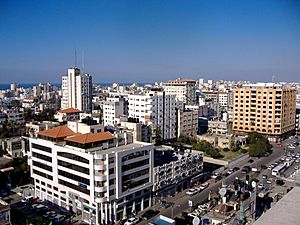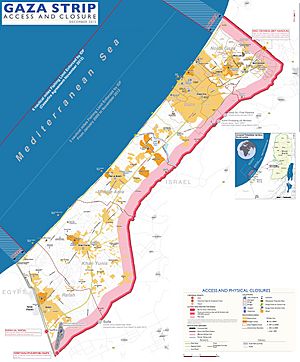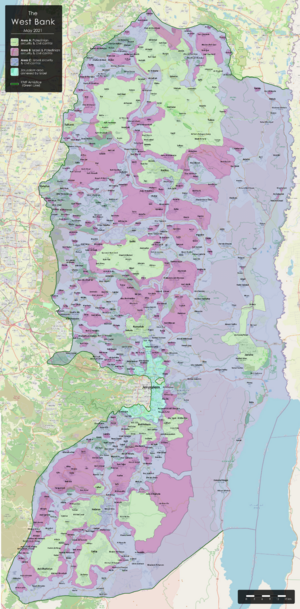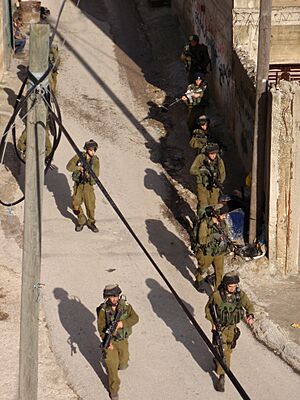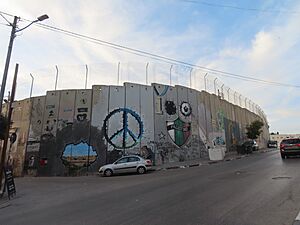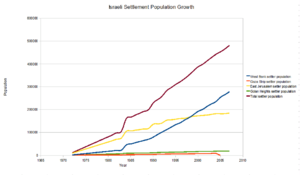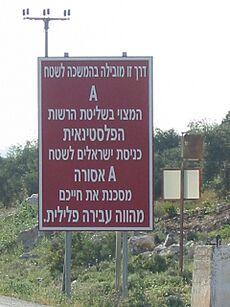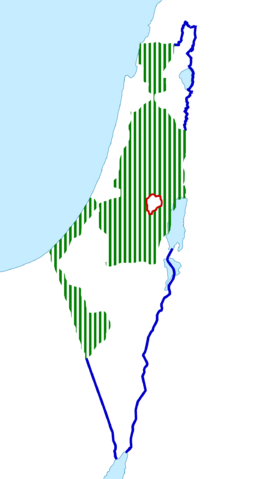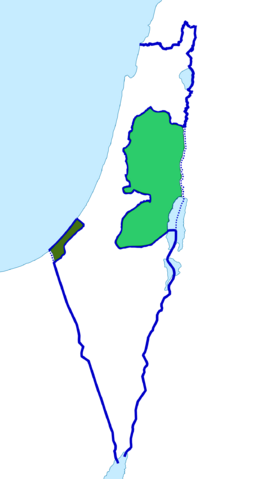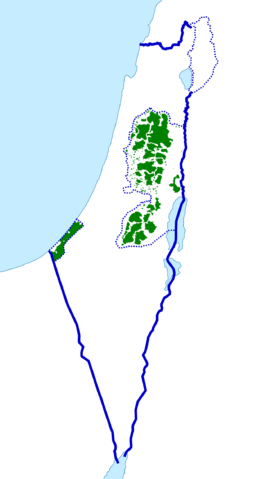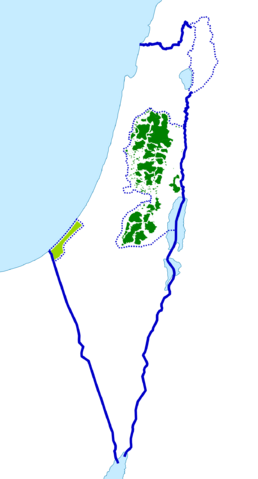Occupied Palestinian territories facts for kids
Quick facts for kids
Palestinian territories
الأراضي الفلسطينية
al-Arāḍī al-Filasṭīniyya |
|
|---|---|
|
Palestinian flag
|
|
 |
|
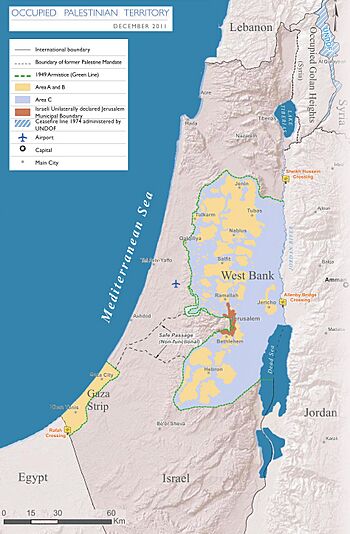
Palestinian territories according to a Green Line based definition
|
|
| Largest cities |
|
| Languages | |
| Ethnic groups | |
| Demonym(s) | |
| Area | |
|
• Total
|
6,220 km2 (2,400 sq mi) |
|
• Water (%)
|
3.5 |
| 5,860 km2 (of which Dead Sea: 220 km2) |
|
| 360 km2 | |
| Population | |
|
• Palestinians (2016)
|
4,816,503 |
|
• Settlers (2012)
|
564,000 |
|
• 2007 census
|
3,719,189 (Pal.) |
|
• Density
|
654/km2 (1,693.9/sq mi) |
| HDI (2010) | 0.645 medium · 97th |
| Currency |
|
| Time zone | UTC+2 (EET) |
|
• Summer (DST)
|
UTC+3 (EEST) |
| Driving side | right |
| Calling code | +970d |
| ISO 3166 code | PS |
| Internet TLD | |
|
|
The Palestinian territories are two areas: the West Bank (which includes East Jerusalem) and the Gaza Strip. These areas were part of the former British Mandate for Palestine. Israel has controlled them since the Six-Day War in 1967.
These territories are considered to be the State of Palestine. The Palestine Liberation Organization (PLO) declared this state in 1988. Many countries around the world recognize it.
The International Court of Justice (ICJ) calls these areas the "Occupied Palestinian Territory." The United Nations and other international groups also use this term. Since 2012, the UN has used "State of Palestine" for the political group, but "Occupied Palestinian Territory" for the land itself. The European Union (EU) also uses this term.
Before 1967, the Gaza Strip was controlled by Egypt. The West Bank was controlled by Jordan. After the 1967 war, Israel took control of both areas. In 1980, Israel made East Jerusalem part of its capital. However, most countries do not agree with this.
In 1988, Jordan gave up its claims to the West Bank. In 1993, the Oslo Accords led to parts of the territories being managed by the Palestinian National Authority. Israel still controls much of the West Bank. The Gaza Strip was also affected by agreements about access to the sea.
Israel left the Gaza Strip in 2005. But in 2007, Hamas took control of Gaza. This split the Palestinian territories politically. Fatah, led by Mahmoud Abbas, mostly rules the West Bank. Most countries recognize Fatah as the official Palestinian Authority.
In 2012, the UN General Assembly voted to make Palestine a "non-member observer state." This was a big step for Palestine.
Contents
Understanding the Palestinian Territories
The Palestinian territories are a key part of the ongoing situation in the Middle East. Many international groups refer to them as "Occupied Palestinian Territory." This means they are seen as land that Israel controls, but which belongs to the Palestinian people.
Where Are the Palestinian Territories?
The Palestinian territories include two main areas: the West Bank (which has East Jerusalem) and the Gaza Strip. These areas are often talked about using the "1967 borders." These borders are actually the armistice lines from the 1949 war, known as the Green Line. These lines were not meant to be permanent international borders.
The West Bank shares a border with Jordan to the east. The Gaza Strip borders Egypt to the south. The Gaza Strip also has a coastline along the Mediterranean Sea. The West Bank's natural border to the east is the Jordan River.
The Idea of a Palestinian State
The United Nations planned for these territories to become the State of Palestine. In 1947, a larger area was set aside for an Arab state. But after the 1948 war, Israel gained control of some of that land. The Palestinian territories now make up about 23% of historic Palestine. This includes areas with Israeli settlements, walls, and roads.
Most countries in the UN agree that a future Palestinian state should be based on the pre-1967 borders. In 2012, the UN General Assembly voted to change Palestine's status to a "non-member state." This was a big step towards Palestine being recognized as an independent state.
East Jerusalem's Special Status

After the 1967 war, Israel took control of East Jerusalem. Israel made it part of its capital city, Jerusalem. However, no other country officially recognizes this. Many UN resolutions have said this action is against international law.
Palestinians see East Jerusalem as the capital of their future state. The UN and other groups usually refer to East Jerusalem as part of the Occupied Palestinian Territory.
The Gaza Strip Today
In 2005, Israel removed its forces and settlements from the Gaza Strip. However, many international groups still consider Gaza to be occupied by Israel. This is because Israel controls Gaza's borders, airspace, and sea access.
A UN report in 2007 stated that Israel still has "effective control" over Gaza. This control is shown by Israel's management of borders, air, and sea, as well as its influence over Gaza's population and economy.
How the Territories Are Governed
The political situation in the Palestinian territories is complex. Since 1994, the Palestinian National Authority (PNA) has managed many parts of the territories. This was agreed upon in the Oslo Accords. The United States sees the West Bank and Gaza as one area for political and economic reasons.
In 2006, Hamas won elections for the Palestinian Parliament. They formed a government. However, the Fatah movement still controlled the PNA security forces. In 2007, Hamas took control of the Gaza Strip by force. This led to two separate governments.
Mahmoud Abbas, from Fatah, leads the government in the West Bank. Hamas controls the Gaza Strip. Most countries recognize Abbas's government as the official one for both territories. The UN Security Council has stated that the Gaza Strip is part of the Palestinian state.
In 2012, Iceland recognized Palestine as an independent state. Other countries have also recognized Palestine. In 2014, Fatah and Hamas tried to form a unity government, but it faced challenges.
Political Status and Future
Most of the world sees the Palestinian territories as occupied by Israel. Even though Israel pulled its military from Gaza, the UN and human rights groups still consider it an occupying power. The goal of many countries is for the Palestinian territories to become an independent state. This is part of the "Road map for peace" plan.
The Oslo Accords led to Israel transferring some powers to the Palestinian Authority. Israel kept control over external security and Israeli settlements. Negotiations for a final agreement have been difficult.
In 2005, Israel carried out a plan to remove all its settlements from the Gaza Strip. It also removed four settlements from the northern West Bank. The Palestinian Authority welcomed this but still viewed Gaza as occupied.
Today, Israel manages most of the West Bank. However, about 42% of it is under some level of self-rule by the Fatah-led Palestinian Authority. The Gaza Strip is controlled by Hamas.
The International Criminal Court (ICC) is an international organization that deals with serious crimes. Many countries that are members of the ICC recognize the State of Palestine. This means Palestine could potentially bring legal cases to the ICC.
In 2012, the UN General Assembly upgraded Palestine's status to a "non-member observer state." This allows Palestine to join international treaties and organizations. It also gives Palestine more legal rights over its claimed territory.
International law generally says that an occupying power cannot build settlements in occupied territory. Many countries and the UN agree that Israeli settlements in the West Bank are illegal.
Israel argues that the West Bank is a "disputed territory," not occupied. They say that UN resolutions give Israel rights to secure borders. They also point out that some settlements are on land that was Jewish before 1947.
Most countries and international groups do not accept Israel's view. They continue to call the West Bank and Gaza Strip "occupied territories."
Who Lives There? (Demographics)
The Palestinian Central Bureau of Statistics (PCBS) estimated that in 2009, about 3.9 million Palestinians lived in the Palestinian territories. Many other Palestinians live in Israel or other countries.
The population in the Palestinian territories is growing quickly. In 2008, there were 3.76 million Palestinians in the West Bank and Gaza Strip. This was a 30% increase in ten years.
In 2009, the population density was 654 people per square kilometer. The Gaza Strip is much more crowded, with over 4,000 people per square kilometer. A large part of the population (41.9%) is under 15 years old.
| Population (mid year) | |||
|---|---|---|---|
| Year | West Bank | Gaza | Total |
| 1970 | 0.69 | 0.34 | 1.03 |
| 1980 | 0.90 | 0.46 | 1.36 |
| 1990 | 1.25 | 0.65 | 1.90 |
| 2000 | 1.98 | 1.13 | 3.11 |
| 2004 | 2.20 | 1.30 | 3.50 |
| 2008 | 2.41 | 1.5 | 3.91 |
| 2010 | 2.52 | 1.60 | 4.12 |
| Source: U.S. Census Bureau | |||
| 2006 | 2.5 | 1.5 | 4.0 |
| 2009 | 2.48 | 1.45 | 3.94 |
| Source: Palestinian Central Bureau of Statistics | |||
| Region | Population |
|---|---|
| West Bank | 2,568,555 |
| East Jerusalem | 192,800 |
| Gaza Strip | 1,657,155 |
| Name | Population (2007) |
Area (km2) | Density |
|---|---|---|---|
| West Bank | 2,369,700 | 5,671 | 417.86 |
| Gaza Strip | 1,416,539 | 360 | 3934.83 |
| Total | 3,786,239 | 6,031 | 627.80 |
Religion and Language
Most Palestinians are Sunni Muslims. The Palestinian constitution states that Islam is the official religion. It also says that other religions should be respected.
Christians make up about 1-2% of the population. There are also a few hundred Samaritans who live in the West Bank.
Arabic is the official language. Palestinian Arabic is the spoken language. Hebrew and English are also widely used. Many Israeli settlers live in the West Bank and mostly speak Hebrew.
Israeli Settlers
In 2012, about 564,000 Israeli settlers lived in the West Bank. This includes about 203,000 in East Jerusalem. The number of settlers in the West Bank has grown steadily since 1967.
How the Territories Are Divided
The Palestinian territories are divided into 16 governorates. These are managed by the Palestinian National Authority. Since 2007, the Gaza Strip and the West Bank have been governed by different groups. Hamas controls Gaza, and Fatah controls the West Bank.
West Bank Areas
The Oslo II Accord created three temporary areas in the West Bank: Area A, Area B, and Area C. These areas are not connected and are based on population and military needs.
- Area A: The Palestinian Authority has full control over civil and security matters. This area includes all Palestinian cities. Israeli citizens are not allowed to enter Area A.
- Area B: The Palestinian Authority controls civil matters, but Israel and Palestine share security control. This area includes many Palestinian towns and villages.
- Area C: Israel has full control over civil and security matters. This area includes all Israeli settlements and the roads connecting them. In 2012, over 300,000 Israeli settlers lived in Area C, along with about 150,000 Palestinians.
A Look Back: History of the Territories
After the Ottoman Empire fell in 1917, the British Mandate for Palestine was created in 1922. During this time, many Jewish people moved to Palestine. In 1947, the United Nations proposed dividing Palestine into an Arab state and a Jewish state. Jerusalem was to be a special international zone.
The Jewish leaders accepted the plan, but Arab leaders did not. In 1948, Israel declared its independence. This led to the 1948 Arab–Israeli War. After the war, the 1949 Armistice Agreements set up lines between the fighting sides. Israel controlled some areas, Jordan controlled the West Bank, and Egypt controlled the Gaza Strip.
In 1950, Jordan officially took control of the West Bank. Egypt managed the Gaza Strip. In 1967, Israel captured both the West Bank and Gaza Strip during the Six-Day War. These areas have been known as Israeli-occupied territories ever since.
After the 1967 war, Israel offered to return land in exchange for peace. But Arab countries refused to recognize or negotiate with Israel at that time.
The Oslo Accords in the early 1990s were a big step. They led to the creation of the Palestinian Authority. This group was meant to manage Palestinian self-governance in the territories for a few years. However, a final peace agreement has not yet been reached.

In 2005, Israel removed its settlements and forces from the Gaza Strip. But in 2006, Israel entered Gaza again after rocket attacks and the capture of an Israeli soldier.
In 2010, Jordan's King Abdullah said that Jordan did not want to rule the West Bank. He believed that a "two-state solution," with an independent Palestinian state, was the only way forward.
In 2010, Brazil recognized Palestine as a state with its 1967 borders. Several other South American countries followed this decision.
Images for kids
See also
 In Spanish: Estado de Palestina para niños
In Spanish: Estado de Palestina para niños
- Outline of the State of Palestine
- Economy of the State of Palestine
- Healthcare in the State of Palestine
- Judea and Samaria Area
- Tourism in the State of Palestine




